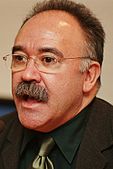Spanish local and regional elections, 2007
|
|
|||||||||||||||||||||||||||||||||||||||||||||||||||||||||||||||||||||||||||||||||||||||||||||
|---|---|---|---|---|---|---|---|---|---|---|---|---|---|---|---|---|---|---|---|---|---|---|---|---|---|---|---|---|---|---|---|---|---|---|---|---|---|---|---|---|---|---|---|---|---|---|---|---|---|---|---|---|---|---|---|---|---|---|---|---|---|---|---|---|---|---|---|---|---|---|---|---|---|---|---|---|---|---|---|---|---|---|---|---|---|---|---|---|---|---|---|---|---|
|
|||||||||||||||||||||||||||||||||||||||||||||||||||||||||||||||||||||||||||||||||||||||||||||
|
66,131 seats in 8,111 local councils 1,038 seats in 38 provincial deputations 153 seats in 3 Juntas Generales in the Basque Country 153 seats in 7 cabildos in the Canary Islands |
|||||||||||||||||||||||||||||||||||||||||||||||||||||||||||||||||||||||||||||||||||||||||||||
| Registered | 35,153,523 |
||||||||||||||||||||||||||||||||||||||||||||||||||||||||||||||||||||||||||||||||||||||||||||
| Turnout | 22,488,232 (64.0%) |
||||||||||||||||||||||||||||||||||||||||||||||||||||||||||||||||||||||||||||||||||||||||||||
|
|||||||||||||||||||||||||||||||||||||||||||||||||||||||||||||||||||||||||||||||||||||||||||||
The 2007 Spanish local elections were held on Sunday, 27 May 2007, throughout all 8,111 Spain municipalities, simultaneously with regional elections in 13 of the 17 autonomous communities—all except for Andalusia, the Basque Country, Catalonia, and Galicia. All 65,869 councillors were up for election, as well as 153 seats of the 3 Basque Juntas Generales, 153 seats of the 7 Canarian cabildos and the indirectly-elected 1,038 seats of the 38 provincial deputations.
The results saw few changes overall; most incumbent governments retained their majority, with only a few exceptions. The PP government in the Balearics fell, and a coalition led by PSOE took power.
While the elections were seen as a first indication of how the Spanish general election, 2008 might turn out, the results proved to be inconclusive. In 2003, the PSOE had a slight edge with 34.8 against the PP's 34.3; in this election, the PP had 35.6 to the PSOE's 34.9. Turnout was slightly lower, with 63.8 instead of 67.7 four years earlier.
The number of seats in each city council was determined by the population count. According to the municipal electoral law, the population-seat relationship on each municipality was to be established on the following scale:
Additionally, for populations greater than 100,000, 1 seat was to be added per each 100,000 inhabitants or fraction, according to the most updated census data, and adding 1 more seat if the resulting seat count gives an even number.
All city council members were elected in single multi-member districts, consisting of the municipality's territory, using the D'Hondt method and a closed-list proportional representation system. Voting was on the basis of universal suffrage in a secret ballot. Only lists polling above 5% of valid votes in all of the municipality (which include blank ballots—for none of the above) were entitled to enter the seat distribution.
...
Wikipedia






